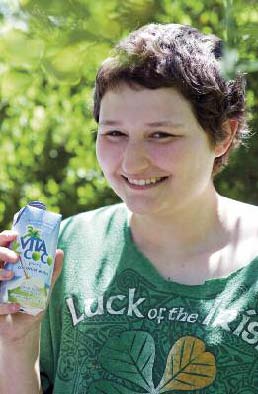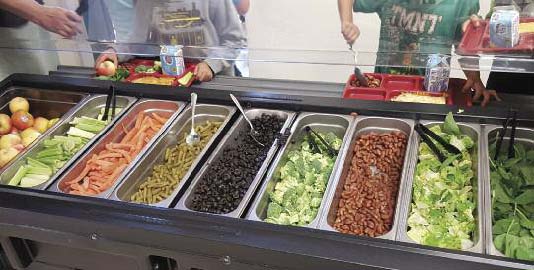feature
FOSTERING STUDENT WELLNESS
School district officials put nutrition and fitness back on the menu.
WRITTEN BY JESSICA SANTINA
PHOTOS BY CANDICE NYANDO AND COURTESY OF TTUSD
In the current political climate, education is a hot topic. School administrators constantly must seek ways to improve test scores, train teachers, and address overcrowding under tight budgetary constraints. Under such demands, recesses, nutrition, and physical education classes are among the first things to go.
But a federal mandate has put nutritious foods, physical fitness, and a healthy lifestyle back on the table. It addresses what researchers have known for years: Students who eat right and exercise perform better in school.
For one, the Local School Wellness Policy — part of the Healthy, Hunger-Free Kids Act of 2010 — requires that every school district participating in the National School Lunch Program and/or School Breakfast program develop its own wellness policy that promotes students’ health and addresses the childhood obesity epidemic. District leaders had to be fully compliant with their policies by the 2015-2016 school year.
Though the policy-rollout process for Reno-Tahoe school districts has brought challenges, it also has led to some innovative approaches to improving student wellness.

Beyond the cafeteria
The federal policy spells out several non-negotiable requirements affecting how schools approach student wellness, and they go beyond what’s served in the lunchroom.
“The rules surround nutrition elements of food served in schools, applying to all foods in schools aside from school breakfasts or lunches,” says Catrina Peters, school nutrition services manager at the Nevada Department of Agriculture. “There also are requirements around physical activity … Nutrition education and promotion are goals as well.”
The Local School Wellness Program picks up where the National School Lunch and School Breakfast programs leave off, affecting all other fare sold or distributed to students during the school day. This extends to classroom snacks, food incentives/rewards, and à la carte items sold in cafeterias for special events, as well as treats available from celebrations, student stores, fundraisers, and vending machines. Foods sold or distributed to students during school hours must adhere to the USDA’s Smart Snacks nutrition standards, which dictate acceptable levels of calories, fats, sugar, and sodium, while emphasizing foods containing whole grains, low-fat dairy, fruits, vegetables, or proteins as their main ingredients.
Among its other requirements, teachers must allow students at least 20 minutes to consume lunch, and they must provide students with opportunities for at least 30 minutes of physical activity each day, which may not be withheld as punishment. The policy also makes recommendations, such as avoiding food-based incentives and rewards.
The policy indicates that as of school year 2006-2007, district leaders had to form citizen advisory communities to establish their wellness policies and appoint wellness coordinators to lead implementation and compliance efforts. The Healthy, Hunger-Free Kids Act of 2010 strengthened those requirements.
Brian Rothe, coordinator of Washoe County School District’s student activities and athletics department, served as wellness coordinator until his recent retirement.
“Putting these regulations into place was an important step,” Rothe says. “It gave legitimacy to increasing student nutrition and physical education.”
Healthy ideas
Beyond the federal requirements, district officials were encouraged to develop their own policies and set goals for nutrition education, physical activity, and other activities that pertain to wellness. District officials around Reno-Tahoe have responded in creative ways.
For example, Douglas County School District is now not only peanut free, but it’s moving toward becoming skin-cancer-free as well, according to Brooke Whisenant, director of school nutrition.
“We just got a grant through Sun Smart Nevada (a project of the Nevada Cancer Coalition) for sunscreen dispensers and a year’s supply of sunscreen for all 12 of our schools, for kids to use before going out for recess,” Whisenant says. “It comes with an educational program about sun exposure as well.”
Other DCSD goals include helping students identify cancer-fighting foods on the school’s menu and securing pedometer donations to encourage students to track their movements at recess.
Cindy Rainsdon, food service supervisor for Lyon County School District, explains that a partnership with the Healthy Communities Coalition in Dayton has brought salad bars featuring fresh, local produce into all 17 of its schools.
Tahoe Truckee Unified School District also has salad bars in its 11 school cafeterias, offering local produce whenever possible. Corine Harvey, executive director of student services, says getting youths to choose more fresh produce at school and elsewhere is a district goal. Tahoe Forest Hospital’s wellness department is helping them meet it with the Harvest of the Month program.
“Volunteers bring cases of produce for the kids to try,” Harvey says. “The kids get to sample healthy things they’ve never tried or even heard of.”
The TTUSD wellness policy also adopts the federal recommendation that students have recess before lunch, not after, in order to discourage children from racing through lunch and throwing good food away.
Winning support
With 65,000 students attending its 93 schools, the Washoe County School District is the second-largest district in the state, which might help explain its relatively late wellness policy implementation and subsequent negative responses from the community. While other Reno-Tahoe district officials began developing wellness policies as far back as 2004, WCSD’s 15-person wellness committee didn’t have its first meeting to address the 2010 regulations until February 2015. Its updated policy was approved in April 2016.
Rothe explains that because the committee is subject to open meeting laws, soliciting input from the public was a lengthy process, but a necessary step in formulating a thorough policy.
“There were a lot of discussions about which things were mandated and which were up to the districts to figure out,” says Kelli Goatley-Seals, chair of the WCSD Student Wellness Advisory Committee. “We discussed everything in detail, which is why it took us so long to put our policy together.”
School officials began implementing aspects of the policy before it was finalized, and inconsistencies between schools led to confusion. Pushback from the WCSD community got media attention as misperceptions flew. Parents worried that the district was regulating what foods students brought from home in their lunches (it wasn’t). They were angry that birthday cupcakes and classroom holiday parties were no longer allowed, though all Reno-Tahoe district policies now include monthly exception days.
Others worried that the list of suggested processed foods that meet Smart Snacks standards — a guide for those stocking student stores and vending machines — were the only foods allowed, though this was not the case.
Finally, an erroneous letter to WCSD principals from school district leaders warned of a $125,000 penalty for wellness policy violations. Yet NDA officials insist there is no fee — only a potential loss of federal funding for serious, repeated noncompliance.
“Our focus is on providing training and technical assistance to get them into compliance,” Peters says. “Once we identify an issue, we get it addressed. When we found that Washoe County didn’t have a policy in place, we worked to get one in place. We’re solutionoriented rather than being punitive. Losing funding would only happen in a really egregious situation. It would only be withheld until [the school] got into compliance, and then we’d release the funds.”
WCSD wasn’t the only district where misunderstandings occurred. Mary Sawyers, nutrition office specialist for the Carson City School District, says her district’s policy was approved in July 2015.
“Our biggest challenge is getting our staff and parents to understand that the wellness policy is a federal mandate, not a district directive,” Sawyers says.
Rainsdon and Whisenant both point to vending machines as a problem. Ensuring that members of the activity groups and parent-teacher associations who run the machines are stocking them in accordance with wellness policies definitely has been a challenge.
Harvey says that TTUSD’s wellness committee anticipated resistance from the community, so once its committee was in place in January 2013, members immediately began communicating upcoming changes to families. They did this through a brochure that highlighted upcoming changes in understandable language.
“We intentionally went slowly and got buy-in in order to get a policy that was adopted by all,” Harvey says.
All district representatives could agree that, despite the challenges, these changes are for the better, and they’re excited about what’s to come.
“So many things we try in education are flashes in the pan,” Harvey says. “This focus on wellness has been consistently building momentum over time, and we’re starting to see impacts. It’s changing the choices kids make, and that’s what we’re looking for.”
Jessica Santina is managing editor of edible Reno-Tahoe magazine and the parent of a 7-year-old daughter who attends school in Washoe County. She has been following the development of the school wellness policy closely, and the more she learns about the policy, the more excited she is by the positive changes to come.
For details about the Smart Snacks nutrition standards, visit http://www.Fns.usda.gov/sites/default/files/allfoods_flyer.pdf


